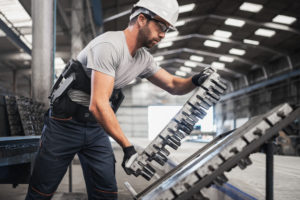Exoskeletons and carrying heavy loads – Read more about it here
Do you have questions about purchasing an exoskeleton for workplaces where it is all about carrying heavy loads? We give you all the information you need for a better understanding and to make your decision easier.
An exoskeleton – What is this?
According to the Larousse definition, an exoskeleton is a motorized, articulated device that can be attached to a body part to facilitate the movement. In truth, an exoskeleton is slightly more complex than that. There are all kinds of exoskeletons available today, for all parts of the body, and they all differ.
An exoskeleton can be passive or active. The main characteristic of a passive exoskeleton is that it has no motorization. These devices are conceptualized in such a way that, with the help of springs, slides, elastics or other components, they transfer the mechanical energy produced by movement or gravity to other parts of the body. These exoskeletons are most often used for very specific and repetitive tasks and movements. For example, they can provide support to a person who works with his arms raised or a person who does a lot of repetitive bending.
An active exoskeleton has mechanical components such as motors, electronic components or embedded intelligence that allows it to intelligently detect body movements. Thanks to the mechanical components, the exoskeleton is able to provide real mechanical support and energy to the user.
An exoskeleton does not enable you to carry more weight and it does not carry the load in your place
An exoskeleton, if it is not connected to a fixed point on the ground, does not allow bringing an additional force to its user. The constraints will always be borne by the user, but transferred to another part of the body. In the end, the distribution of the load is changed.

In short, an exoskeleton is not designed to increase the strength of its user or to carry a load in his place, but rather to relieve a strong strain on a weakened part of the body.
The Japet.W: An exoskeleton adapted to carry heavy loads
The Japet.W exoskeleton is the perfect example of an active exoskeleton that will relieve stress and, above all, relieve the user wearing it. The Japet.W exoskeleton is therefore an exoskeleton that is adapted to carrying loads. Due to its motors and its intelligence, it adapts to the body’s movements and allows the force to be adapted to different loads. Unlike a passive exoskeleton, it will assist with all movements and not exclusively with an isolated movement such as lifting.
It does not enable to increase the productivity by multiplying the strength of its user, but, certified as a medical device, it promises to relieve the people suffering from lumbar pain and to allow them to maintain their work in the long term. The Japet.W also helps to fight against MSDs.

Thanks to its motorization, it allows to reduce the pressure on the discs and to free the nerve roots. It is therefore also recommended for risk prevention in workplaces with high stress on the lumbar spine. Indeed, the Japet.W also makes it possible to secure gestures and postures by accompanying the movements.
In short, the Japet.W exoskeleton is a solution to relieve workers who are subject to strong lumbar straints at their workstation and/or who suffer from disk-related low back pain. Due to its motorization and its adaptation in all situations, the Japet.W is suitable for carrying heavy loads.
More information about the Japet.W right here.
Don’t hesitate to contact us.
